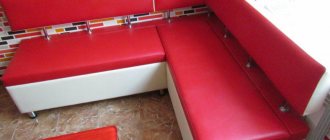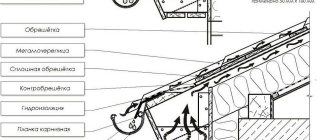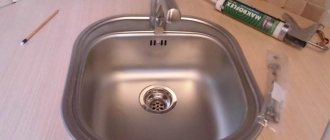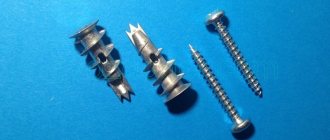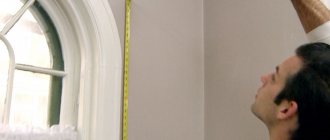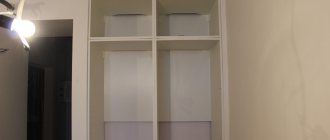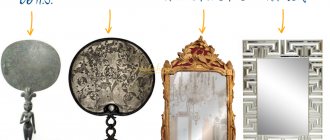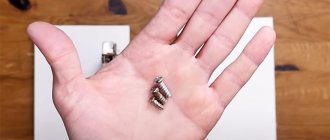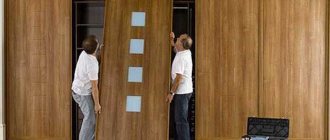Drilling the wall
Craftsmen use a hammer drill, but for a home workshop, an electric drill with a power of ≥ 600 W is usually purchased. It is advisable to have a tool with continuously adjustable speed and a quick-release chuck. It is convenient if a hammer drilling function is provided, making the activity easier.
Wooden, foam concrete walls, as well as partitions made of plasterboard, can be drilled using a regular drill. More durable materials - concrete, brick - will require a carbide drill with pobedite surfacing at the end. If a hole > 15 cm in length is expected, then a hammer drill with a drill is used.
Holes in the walls have to be drilled for different purposes. They are mainly needed for securely fixing wall cabinets. At the preparation stage, the wiring diagram must be clarified to avoid damage. The drill gets very hot during operation, so it needs to be dipped in water periodically.
The brick should be drilled at low (up to 400) speeds in impact mode, pressing quite firmly on the handle and holding the tool strictly vertically. It is more difficult to work with high-strength concrete, since the Pobedit drill often rests on the reinforcement. To pass the obstacle, it is replaced with a regular drill. If a strict straight line of the hole is not a prerequisite, then you can shift the drilling direction. Stones in concrete are crushed with a narrow chisel inserted into the hole, hitting it with a hammer.
When placing the cabinet on a tiled wall, first remove the glaze in the designated areas with a sharp object. To make a hole of a given depth, you can take a piece of cylindrical cambric of the required diameter and length, put it on the drill, resting it tightly against the chuck.
Expert advice: If you can’t find a suitable tube, then ordinary insulating tape, which is applied to the drill in several turns, will help. This technique will eliminate the need to constantly monitor the depth of the drilled hole.
Clasp sizes
The main group of clamps is divided into six standard sizes. The choice directly depends on the thickness of the building material used in the process of finishing the room.
- No. 1 - Used when finishing with vinyl lining and wall panels
- No. 2 - For fastening MDF and vinyl lining
- No. 3 - Used for eurolining and chipboard panels
- No. 4 - fasten the eurolining
- No. 5 - suitable for wooden linings of heavy species, such as linden and aspen
- No. 6 - used for block house
Widely used standard clamps were mentioned above.
But these are not all types of clamps. There are clamps of a specific design used for fastening other building materials. Their design has a specific form, and production and sale are carried out as an addition to the main material. An example of “unusual” clamps are fastenings for decking boards, seam roofing, and others. On the right in the photo you can see how the terrace board is installed. In this case, the clamp has the shape of a butterfly, and the fixation on the material occurs by snapping it onto the groove of the board (like a clip). Such fasteners are not widely available and can be purchased as an addition to the decking board from manufacturers or suppliers.
Useful drilling tools
Many home craftsmen have encountered the problem of the drill moving from the intended point due to the heterogeneity of the walls. This leads to the fact that the exact horizontal line is lost and it is not possible to hang a shelf or other piece of kitchen furniture straight.
In such a situation, craftsmen recommend that you independently prepare a sheet of plywood with a hole (a jig) through which the drilling will be carried out. To prevent it from moving when applied to the wall while the drill is operating, double-sided tape or sandpaper is glued to the surface oriented to the plane being drilled. For versatility, you can make several holes of different diameters. If you provide one edge with a plate attached at a right angle, then the dust will not fly away, but almost all of it will settle on this shelf.
To secure cabinets, it is often necessary to prepare holes with a specific distance. Here the conductor will also come to the rescue, on which precise markings are made, and two holes are prepared. Further actions will be aimed at drilling the first socket for the dowel in the wall, in which one side of the conductor is attached with a self-tapping screw. All that remains is to level it using a building level and drill a second hole.
Recommendations for choosing a model
To purchase a ready-made corner shelf, adhere to the following recommendations:
- Initially, measure the room in which they plan to install the product. Determine the installation location. In small rooms, shelves are placed next to other furniture, hung above the kitchen table, sink or sofa.
- Illuminating furniture visually increases the space of the kitchen.
- The selected product must correspond to the overall style of the interior.
- Wood fits into most modern styles, but is expensive. To save money, purchase furniture made from chipboard or MDF.
- In large rooms, corner shelves are installed in a chaotic manner. This gives the interior originality.
When making custom-made furniture, they turn to specialists who will take all measurements. In this case, an important indicator is taken into account - angle reversal. It is not always 90°. The central joints of a standard shelf may not meet, and it will lose its appearance.
Selection of screws
Traditional fastening of shelves, cabinets, cornices, and decorative elements is done using self-tapping screws, which in their design have a head and a thread with sharp edges, which, when screwed, allows you to independently cut threads in the dowels into which they are screwed. They are selected according to the predicted load.
The material is steel - most often carbon, but stainless steel is also found, as well as brass. Carbon steel products have a protective coating. Self-tapping screws differ according to the thread pitch, which can be frequent, universal, rare. The first type is designed for working with iron surfaces. A rare step is suitable for wood, plastic and other soft materials. Universal varieties are used more often.
There is a separate type of self-tapping screws designed for concrete structures. They are screwed directly into the hole without installing a dowel. This mount cannot be dismantled, so it is rarely used. When choosing the dimensions of the screw, it is necessary to take into account the structure of the wall. The more pores there are, the longer and thicker the dowel and the corresponding self-tapping screw should be selected.
What is a kleimer
What is a clamper - types, sizes, applications
The main material for the manufacture of clamps is spring steel. In essence, a clamp is a mounting bracket with which you can easily and secretly fix finishing materials to a wooden sheathing.
The name of the word kleimer comes from the German “Klammer”, which literally means: clip, clamp, staple, clamp, paper clip. Today, this type of hardware is widely used in construction.
The kleimer is used when a seam roof is being installed, a house is being finished with clapboards and block houses, for fixing terrace boards, wall panels and MDF.
Selection of dowels
When choosing the optimal wall mount, inexperienced craftsmen make several mistakes.
- The diameter of the dowel turns out to be larger than that of the self-tapping screw. Such a design will not fit tightly into the hole and will not allow sufficiently heavy kitchen cabinets to be securely fastened.
- If the diameter of the dowel is smaller than that of a self-tapping screw, the latter will not be screwed in completely, creating obstacles for further hanging a piece of furniture on it that will not be able to hang tightly to the wall.
The most rational solution is to purchase a ready-made set of dowels with self-tapping screws. For drywall there is a dowel equipped with a drill, and there is also a special type of similar product known as the “Butterfly”.
Advantages of using clamps
Using a clamper instead of nails and screws, as was previously the case, allows you to achieve the following advantages:
- Increase the speed and quality of installation work;
- Avoid damage to finishing materials in the process of fixing them to the sheathing;
- Get a beautiful surface without a single visible fastener;
- Easy to use, since the technology for fastening the clamps is nothing complicated.
- Excellent operating conditions: no instability of products and their loosening during operation, non-susceptibility to corrosion and other destructive processes.
Kleimer is a popular type of fastener today. Many repair and finishing works cannot be completed without its use.
This hardware allows for a reliable and hidden connection, and a wide selection allows you to select fasteners of the desired shape and size.
Advantages of tire mounting
A fastening system has proven itself, consisting of a rail, which is a perforated strip of metal with a protruding part designed to be held by hooks located on the inside of cabinets.
Such a mount has a number of obvious advantages:
- quick installation, accessible to a beginner;
- cabinets can be hung effortlessly on a prepared rail, without helpers;
- if leveling is necessary, the height is adjustable;
- the fit of the cabinet after hanging it can also be adjusted in depth;
- The tire can be divided into pieces of the required length.
In the store, you should pay attention to the package, since fastenings in the form of tires and canopies may be included in its composition. In this case, you can be sure that the manufacturer has foreseen the possible load and provided reliable fasteners.
When starting to hang kitchen cabinets, you need to secure the awnings to them with self-tapping screws, placing the hooks in the middle position. Another position is allowed, but this is considered the most optimal.
Using a level, the position of the tire is marked on the wall, holes are drilled and the structure is secured with dowels. Once the cabinet is securely installed, a control measurement of its exact position is carried out. If necessary, it is leveled. If several hanging pieces of furniture are placed nearby, they are fastened together using a clamp. It is advisable to lay thin insulating material between the walls to avoid damage.
How to adjust cabinet doors: step-by-step instructions
Door distortions, their loose fit, difficulties with opening/closing - there are quite a lot of problems typical not only for new furniture after its assembly is completed, but also for old ones. First of all, this applies to elements of kitchen units, the awnings of which are affected by changes in humidity, temperature, and their high values. As a rule, most defects that appear can be eliminated by adjusting the hinges on cabinet doors. And the services of a specialist, if you understand the meaning of all operations, are definitely not needed.
All a home craftsman needs is a cross-head screwdriver, since the awnings are fastened with self-tapping screws. And, of course, an understanding of what needs to be done.
Where to begin
- Assess the correct installation of furniture. If it is skewed (uneven floors, differences in the height of its legs), then adjusting the cabinet doors may not help. Therefore, it is necessary to eliminate this shortcoming. Controlling the position of furniture is best done using a building level or plumb line; It is quite difficult to visually determine deviations from the vertical, especially minor ones.
- Inspect the awnings. This is necessary, firstly, to determine their type (the methodology for further work largely depends on this), and secondly, their condition. If the fasteners are loosened, adjustment will not be necessary; You just need to tighten the fasteners more tightly.
- Determine the type of regulation. It depends on how curved the cabinet facade is, where there are large and small gaps between its doors, in which area the fabric catches, and so on. Then it will become clear how exactly it should be adjusted: in height, depth or width.
Operating procedure
It should be noted that the first time you may not get the desired result. And this depends not only on the qualifications of the master. Many malfunctions are caused by several reasons, each of which entails certain negative consequences for the correct opening/closing of doors and their position on the cabinet facade. Therefore, adjustment is often carried out comprehensively, along several axes.
By height
This is necessary in case of obvious distortion. It begins to touch the bottom or top of the cabinet partitions with its upper cut; difficulties arise with closing tightly, since adjacent doors literally rest against each other with the ends of the panels.
In most types of hinges, the screw, which is responsible for the vertical displacement of the blade, is located in a round rather than an oblong hole, stretched in the form of an ellipse. It is always located closer to the sash.
When determining how to adjust cabinet doors, you need to consider that their position is affected by both canopies. It is necessary to loosen the fasteners, move the blade, tighten the screws slightly and check for opening/closing. As a rule, two or three attempts are enough, and the deficiency is eliminated.
Width (depth)
Here you will have to “work” with another screw. It is easy to determine by its installation location - it is further from the edge of the section, and the landing “window” has an oblong shape. This is what allows you to find the optimal position of the hinge relative to the wall of a kitchen or other cabinet. The fastener becomes loose and the moving part of the canopy either moves inward or is pulled out. The adjustment range is determined by the length of the “window” in which the screw is located.
The technique is identical: loosening the adjusting element - changing the position of the door - tightening the fasteners - assessing the result of the work. But in this case, you will have to screw in/unscrew both screws (both the far and the near), otherwise the hinge simply will not budge.
The question of how to adjust cabinet doors equipped with a closer also does not seem difficult. As a rule, this is necessary if there is a loose fit or slow closing (increased inertia). Such mechanisms differ only in the specifics of installation (on the hinges, between them), but their “tuning” is carried out according to a single algorithm. It all comes down to changing the position of the screw, which affects the intensity of movement of the spring. During the regulation process, it is weakened or tightened.
Adjusting the hinges is not done at once, and there is no need for haste; This kind of work requires extra attention. To install the sash in the desired position, you will have to perform several, sometimes identical, operations. But each of them is an experience, and therefore it will take much less time to eliminate the distortions of the second and third doors.
bestdoor.guru
Other types of fasteners
To hang several rather heavy cabinets on self-tapping screws already screwed into the wall, you can attach a strip to their back surface. This flat piece has a slot that resembles a keyhole in configuration. It is selected so that the diameter of the widest part of the hole is slightly larger than the head of the screw. The narrow part of the hole should be slightly larger than the diameter of the thread. When hanging the cabinet, the head of the self-tapping screw enters the wide part of the slot, and then moves under weight into the narrow zone, ensuring reliable fastening.
If you need to fix a fairly heavy object on the wall, made with plasterboard sheathing, then you can first make a hole with a diameter of ≈ 3 cm in the area of the fastening room, through which a solution can be introduced into the empty space, allowing you to create a strong bridge to the wall.
You can simplify the process if you correctly calculate the length of the screw. In order for the kitchen wall cabinet to be firmly fixed, several values are added up: the thickness of the drywall, the gap from the finish to the wall, the layer of plaster, the depth of the hole in the wall itself.
What is a kleimer
Kleimer is a special type of hardware product that is used as fasteners for all kinds of finishing and building materials. And if previously nails were used to secure various sheet piling materials, such as lining, decking boards, etc., today they have been successfully replaced by clamps.
There is probably no need to go into depth about the disadvantages of using ordinary nails for fastening lining, and other similar tongue-and-groove materials. During this process, materials often cracked and nails rusted, causing permanent corrosion stains on the finish. Nothing like this happens when using a clamper.
Clasp sizes
It is very simple to fasten the lining or block house using clamps. For these purposes, the clamp is installed in the grooves available on the finishing material, after which the hardware, through technological holes, is fixed to the previously assembled sheathing of wooden blocks. The clamp is attached to the sheathing using galvanized nails or wood screws.
Today, depending on the finishing materials used, there are 6 standard sizes of the clamp:
- Claymer 1 - used for finishing surfaces with wall panels or vinyl lining;
- Kleimer 2 - used for fastening lining and MDF;
- Kleimer 3 - this type of fastening hardware is used to fix chipboard panels and eurolining;
- Kleimer 4 - mainly used when installing eurolining;
- Kleimer 5 - serves for fixing finishing materials from “heavy” wood;
- Kleimer 6 - used when decorating the walls of a block house.
It is advisable to note that these are not all types of clamps and their standard sizes that exist today. You can find highly specialized hardware products for sale or on order, which are used for fixing a wide variety of building materials.
Such building materials include seam roofing, decking boards, and many others. A special type of clamp is the butterfly clamp, which has a special connector for snapping into place in the form of a clip.
A separate type of this fastener includes roofing clamps, which are used exclusively for the installation of metal roofs.
What types of clamps are there? How to choose the right lumber and how to secure it
When carrying out facing work or interior decoration, you cannot do without reliable fasteners. Recently, clamps have gained particular popularity. They allow you to create smooth walls, ceilings or facades without visible fasteners.
What is a clamper for?
Clamps are metal staples that are designed for strong, reliable fixation of lumber. With their help, building materials are imperceptibly and neatly attached to the sheathing or cleaned wall surface. This type of fastener has been used for decades, having a number of significant advantages over the familiar nails and self-tapping screws.
Types of clamps
Fasteners are made exclusively from galvanized iron or spring steel, which has sufficient strength and low elongation.
Photo 1. Reinforced clamps for installing imitation timber.
This type of brackets comes in several types:
- special - used for carrying out manipulations on building facades, during laying porcelain stoneware slabs and tiles;
- for mounting plastic;
- for fastening lining, block house and other wooden facing materials.
The second subcategory includes 6 types, depending on the size of the clamp for the lining:
- No. 1 - for plastic panels, vinyl lining;
- No. 2 - manipulations with MDF boards;
- No. 3 - chipboard and eurolining are fastened;
- No. 4 - special clamps for eurolining, corresponding to the standard height of the panels;
- No. 5 - holds heavy wood slats, increased number of holes for installation;
- No. 6 - used when installing a block house.
Cleaver sizes and other characteristics
All products are classified by size and marked with numbers from 1 to 6. They should be selected depending on the thickness of the board fragment (lamella) that includes the holding hook:
- No. 1 is used for installation of vinyl lining and wall panels;
- No. 2 is used for vinyl lining and as clamps for MDF (analogous to chipboard, but made using a different technology);
- No. 3 is suitable for eurolining and chipboard panels;
- No. 4 – these are clamps for eurolining;
- No. 5 is taken for lining from linden and aspen, as a heavier species;
- No. 6 is used for a block house as the strongest fastener.
Sometimes finishing is carried out with materials uncharacteristic for this case, for example, laying laminate on the walls. Then you purchase a rather specific laminate clamp, which is also quite strong. The clamps are supplied complete with nails or screws. Determining the required quantity for the upcoming work is very simple: you need to divide the length of the board (lamella) by the fastening step (50 cm) and multiply by the number of boards needed for finishing. To be on the safe side, you can add a dozen sets. Depending on the method of fastening, these products can be visible or hidden. A thin plastic film, painted in the color of the finishing slabs or plates, is applied to the front surface of visible clasps.
The classification is broader in terms of functionality. Start or end fasteners are used to install the first and last rows of cladding. They have two unidirectional hooks, installed at the corners of two facing slabs, each holding two slabs. Ordinary clasps have two pairs of multidirectional hooks that hold the corners of four slabs. End or side fixtures have one or two multi-directional hooks and are installed on the vertical sides of the finishing slabs to prevent horizontal movement.
Facade and roofing elements
Currently, hinged ventilated facades are very popular. To install the finishing layer of such a facade, façade clamps are used. These are reinforced stainless steel fasteners capable of holding fiber cement, porcelain stoneware, ceramic slabs, aluminum plates and other facing materials. Facade fastenings are made from high-quality steel, because... These structural elements bear the load from the weight of finishing materials and are exposed to environmental influences.
They are also used for the installation of seam roofing (metal roofing, the sheets of which are joined using the seam joint method). Roofing fasteners are metal plates with holes that fit inside the seams. Then they are used to attach roofing sheets (pictures) to the rafters. This installation method ensures high reliability and does not require drilling holes in the roofing material. Roofing clasps are made of brass, copper and stainless steel; they can be movable (floating) or fixed.
Fixed fastenings can be used when installing short paintings. Long pictures can only be mounted using movable ones, due to possible thermal expansion of the material. You can attach the assembled sheets to the rafters with both nails and screws. Clippers are produced for already formed sheets, as well as for manual forming. The first one is produced with already bent edges, and you need to select it to match the size of the edges of the roofing material.
When choosing roofing clasps, you need to be guided, first of all, by the correct selection of materials. To ensure that galvanic couples do not occur, the fastener material must match the material of the sheets. An exception may be stainless steel fasteners. To secure the roof in the main areas, a pitch of 40-50 cm is recommended, while at the edges the pitch should be reduced to 35 cm, and in the corners even to 25 cm. Based on this, you need to calculate the number of fastening kits.
It is more rational to purchase roofing material and all fastening elements from one supplier. This protects against dishonest fulfillment of warranty obligations.
Panel installation technology
A clamp for MDF is a special plate made of perforated metal, which is used to fix MDF panels during their installation. A special feature of this device is “hidden” installation - a method of installing the panel in which the latch itself remains hidden under it and does not spoil the overall picture.
The clamps are marked in the form of numbers 1-6, which reflect the distance from the base (platform) to the tongue of this device. For MDF panels, devices with a gap of 2 mm or more are usually used, but in each specific case, clamps must be selected based on the thickness of the wood.
The use of these devices also has its advantages over other types of fixation of MDF panels:
- traces of installation are not visible, since the clamp is hidden by the casing and support rail;
- fastening material (screws, bolts, etc.) does not damage the panel during installation;
- The clamps are easy to install and remove;
- the cost of this fastener is lower than the cost of other fastening devices;
- Claymers allow you to save money - about 200 pieces are enough to cover an area of 10 square meters with panels.
The average price of clamps for MDF panels is up to 50 rubles per package of one hundred pieces.
MDF panel is a finishing material made from wood chips pressed under high pressure. The panels have the following advantages:
- a high-quality MDF panel does not contain phenolic compounds and resins, and wood chips are glued together by the substance lignin, which is released by wood;
- the material is more resistant to liquid and moisture than natural wood;
- panels provide additional insulation from noise and temperatures;
- the material is easy to process, install on the ceiling and dismantle;
- the panels do not require painstaking care and are easy to clean;
- the cost of MDF ceiling panels is lower than the cost of panels made of natural wood;
- the appearance of this material completely imitates real wood.
The disadvantages of the panels include:
- relatively low strength and resistance to mechanical damage;
- fire hazard;
- the need to hide electrical wiring in a metal sheath in case of its possible contact with the panels after their installation.
The best way to fasten MDF panels is to use clamps.
Before installation, the number of panels is also calculated according to the following scheme: the width of one side of the ceiling is divided by the width of the panel, and a couple of panels are added to the resulting amount in case of defects.
Before attaching the MDF, you need to prepare the tool:
- tape measure and level;
- attachment for a drill or screwdriver;
- fitter's square;
- electric jigsaw or fine-tooth saw.
Before installing the MDF panels, a sheathing is formed on the ceiling. To do this, markings are made on its surface, onto which wooden slats are then attached, making a step of 65 cm between the screws.
The optimal size of the lathing slats is 4 cm wide and 2 cm thick. The maximum distance between the slats can be 50 cm, and a gap of about 1 cm should be left between the wall and the slats.
The lathing is installed using the following technology:
- if the ceiling is uneven, determine its lowest point, which will serve as an indicator of the indentation of the slats from the surface level, or they retreat a few centimeters from the ceiling level and form a sheathing frame around the perimeter of the room;
- at the most protruding point, they attach the first rail, along which the rest will then be leveled, or they begin to fix the slats to the frame on the walls;
- The slats are screwed with self-tapping screws so that their caps go a couple of millimeters above the bottom plane of the wood.
The next stage of creating MDF ceilings is the installation of panels using the following technology:
- the first panel is mounted with self-tapping screws from the corner of the room;
- the next panel is fixed with a clamp inserted into the groove of the first panel;
- long panels are shortened with a jigsaw or saw, and holes are drilled for the communications outlet using a crown-shaped nozzle;
- if the last panel does not fit, it is cut off and fixed into the walls with self-tapping screws;
- After all the panels are secured to the ceiling, a decorative plinth is installed that will hide the screws that secure the first and last panels to the sheathing.
Using a clamper instead of nails and screws, as was previously the case, allows you to achieve the following advantages:
- Increase the speed and quality of installation work;
- Avoid damage to finishing materials in the process of fixing them to the sheathing;
- Get a beautiful surface without a single visible fastener;
- Easy to use, since the technology for fastening the clamps is nothing complicated.
- Excellent operating conditions: no instability of products and their loosening during operation, non-susceptibility to corrosion and other destructive processes.
Kleimer is a popular type of fastener today. Many repair and finishing works cannot be completed without its use.
This hardware allows for a reliable and hidden connection, and a wide selection allows you to select fasteners of the desired shape and size.
Fasteners for lining and block house
Clamps for lining are brackets made of stainless or galvanized steel, sufficiently rigid to ensure strong and reliable fastening of the material. Lining differs from a simple board by the presence of a longitudinal groove on one side and a longitudinal rib on the other. Installing it with the help of such fasteners is quite simple; any novice home craftsman can cope with this operation.
The first board is installed strictly horizontally (or vertically) in level and secured with two self-tapping screws. Then the hooks of the clamps are placed in the groove of the board and attached to the sheathing in increments of about 50 cm. The next board is installed edgewise into the groove of the previous one, tapped with a rubber hammer, adjusted with a level, and the operation is repeated. Fastening the lining with such devices ensures durability, strength, reliability and complete absence of damage during installation and dismantling. The same method is used to use clamps for PVC panels.
Block house is often used as a finishing material - a high-quality finishing material that imitates timber. The block house is made from solid wood and, like lining, has a groove and an edge, thanks to which the lamellas (boards) are connected and create a smooth and beautiful surface. The dimensions of the clamps with which the block house is mounted differ from the devices for lining, but the design and principle of operation are the same. All fastenings of this type provide a connection that is invisible on the front side, emphasizing the aesthetics and nobility of walls made of natural wood.
Hidden fastening of furniture parts. (kitchen cupboard)
How to connect the parts so that the fasteners do not ultimately spoil the appearance of the product?
Of course, glue them together, according to the classics, on dowels/chops.
Yes, for laminated chipboard parts this method is also allowed, but it is not used due to the increased assembly time. Previously, I remember such glued cabinets were delivered as ready-made sets from Italy, somewhere in the Moscow region.
According to the technology, for high-quality gluing and the absence of an adhesive seam, the parts must be tightened with special large clamps
I didn't have this goodness. Buying it is quite expensive.
I got out of it the best I could:
the result of such perversions was a kitchen without visible fasteners and plugs.
A few more photos of this kitchen
